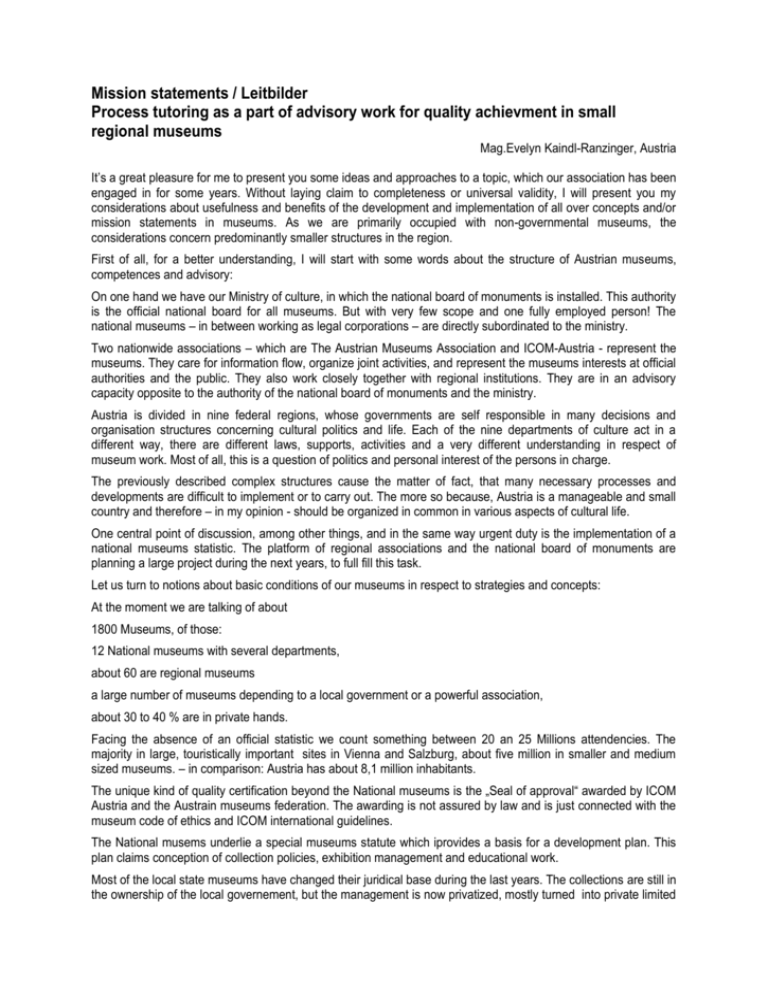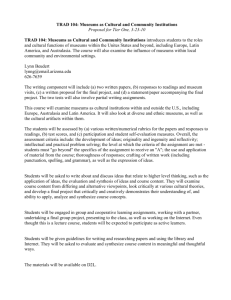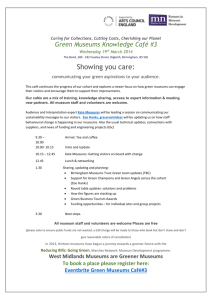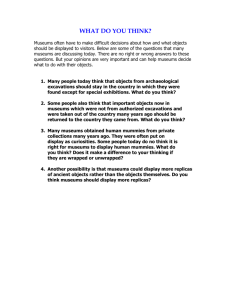Mission statements / Process tutoring as a part of topical advisory
advertisement

Mission statements / Leitbilder Process tutoring as a part of advisory work for quality achievment in small regional museums Mag.Evelyn Kaindl-Ranzinger, Austria It’s a great pleasure for me to present you some ideas and approaches to a topic, which our association has been engaged in for some years. Without laying claim to completeness or universal validity, I will present you my considerations about usefulness and benefits of the development and implementation of all over concepts and/or mission statements in museums. As we are primarily occupied with non-governmental museums, the considerations concern predominantly smaller structures in the region. First of all, for a better understanding, I will start with some words about the structure of Austrian museums, competences and advisory: On one hand we have our Ministry of culture, in which the national board of monuments is installed. This authority is the official national board for all museums. But with very few scope and one fully employed person! The national museums – in between working as legal corporations – are directly subordinated to the ministry. Two nationwide associations – which are The Austrian Museums Association and ICOM-Austria - represent the museums. They care for information flow, organize joint activities, and represent the museums interests at official authorities and the public. They also work closely together with regional institutions. They are in an advisory capacity opposite to the authority of the national board of monuments and the ministry. Austria is divided in nine federal regions, whose governments are self responsible in many decisions and organisation structures concerning cultural politics and life. Each of the nine departments of culture act in a different way, there are different laws, supports, activities and a very different understanding in respect of museum work. Most of all, this is a question of politics and personal interest of the persons in charge. The previously described complex structures cause the matter of fact, that many necessary processes and developments are difficult to implement or to carry out. The more so because, Austria is a manageable and small country and therefore – in my opinion - should be organized in common in various aspects of cultural life. One central point of discussion, among other things, and in the same way urgent duty is the implementation of a national museums statistic. The platform of regional associations and the national board of monuments are planning a large project during the next years, to full fill this task. Let us turn to notions about basic conditions of our museums in respect to strategies and concepts: At the moment we are talking of about 1800 Museums, of those: 12 National museums with several departments, about 60 are regional museums a large number of museums depending to a local government or a powerful association, about 30 to 40 % are in private hands. Facing the absence of an official statistic we count something between 20 an 25 Millions attendencies. The majority in large, touristically important sites in Vienna and Salzburg, about five million in smaller and medium sized museums. – in comparison: Austria has about 8,1 million inhabitants. The unique kind of quality certification beyond the National museums is the „Seal of approval“ awarded by ICOM Austria and the Austrain museums federation. The awarding is not assured by law and is just connected with the museum code of ethics and ICOM international guidelines. The National musems underlie a special museums statute which iprovides a basis for a development plan. This plan claims conception of collection policies, exhibition management and educational work. Most of the local state museums have changed their juridical base during the last years. The collections are still in the ownership of the local governement, but the management is now privatized, mostly turned into private limited companies, but the detailed systems vary from case to case. These institutions have worked out their own mission statements. Each collection in public ownership (nation, local authority or municipal authority) underlie officially the monument protection statute by the ministery of culture and so far they are listed buildings and objects. A huge scene of local privat museums or similar institutions (almost-museums) has grown up in Austria for historical causes. The definite reasons for this matter of fact are still to be analysed. Probabely it comes from an intense private collecting activity, which started at the end of the 19th century, and has been faciliated by a more or less secure economical background in the upper social levels. During the 1980s Austria underwent an explosive multiplication of museums relating to a certain romantic view and quest for the past in times of speed and loss of roots. It seemed as there was uncontrolled growth. Private museums are basically independent. Each federal country has its own advisory system, partly supported by the governement, partly organized in private associations, and in one case as department of a limited company. There is no obligation for them as they are not touched by any statute or accreditiation. So let me now turn back to the topic of my contribution: In our professional context we always talk about „changing situation, changing substructures and backgrounds“. Beyond doubt we are all subject to similar conditions concerning financial bases (getting worse), increasing claims in education, pedagogical work, entertainment and design (more and more sophisticated), and moreover the reinforcement of competition caused by enhancement of mobility. Furthermore, small-structured regional museums, frequently managed and lead by „lone fighters“, shaped by personal enthusiasm, are less and less able to persist and survive beside modern entertainment, despite their richness. Enthusiasm and interesting collections, variocity and regional specification are not enough anymore to attract visitors, to fascinate partners, to convince regional governments of the importance of a museum. Aims, structures and communication must be clear and visible. Feasibilities and limits of performance and benefits have to be apparent for partners, visitors, stakeholders, and investors. How to find a way to form a „model“ of a regional, small museum? Leitbild – mission statement – all over concept – what does this mean? Leitbild, directly translated, might be expressed as „leading model“ The international term „mission statement“ is also used in the German language, but the meaning (in German) is not as broad as the term „Leitbild“. It concerns primarily the strategies, with which an institution transfers and communicates the internal concept outwards. So I will partly use the term „leading model“ in my further explanations. The development of leading models descends from corporate strategy in an economic context. Leitbild means a clearly structured, long term objective of a business or an institution. It contains the different strategies for reaching the defined aims of the institution. So far, Leitbild is a kind of verbalisation of corporate culture in respect to the following functions: Orientation: Values, standards, generally accepted common rules Integration: staff identification and inclusion, corporate identity, internal communication Decision: authorities, rules for crisis management, leadership Coordination: staff, leaders, external partners, … Communication: customers, target groups, stakeholders, communication of internal aims, duties and decisions Behaviour and attitude of the staff become integrated and consistent and therefore revisable. Integrated strategies and ways of information minimize misunderstanding. Why do institutions / museums need leading models? In the rich and dense scenery of a museum of today polarisation and uniqueness is indispensable. During the last 50 or 60 years the world has changed radically from our point of view: In former times, when people were concentrated in their direct regional environment, local collectors and museums featured „the world“, which people could not travel to, close to them. Today, in times of increasing worldwide mobility, choice and chances for everyone dilate, offers abroad get appreciated, museums in far away neighbourhoods become hard competitors. The vital question for all regional museums determining their existence will be, if the institution succeeds in developing and carrying a distinctive brand and polarisation. Furthermore there is the must of working professionally and scientifically relevantly, to persist. Due to the traditional attitude of the „lone fighter“ in his or her museum, who collects enthusiastically, putting his heart and soul in it and finally opening it for public access, collections of invaluable social historical worth have been saved until now. But now, times have come, when we are challenged together with partners in politics, economy, education and tourism, to find ways to harness the collections and their immanent cognition for the future Our benchmarks are international criteria in spite of small, partly private structures and limited financial resources. The base for an effective operation is the motivation and identification of all staff members regarding to the aims and strategies of the institution. Staff members of all levels -each of them in a very special manner- have to be included in the process of model discussion and development of the distinctive brand to get through to this aim. This is exactly what makes the staff committed to the objectives of the leading model. That’s why the process of development, and in the next step, the implementation and communication is so important for its later successful working. Contents and strategies It is obvious now that the shaping of a leading model or mission statement is just to come about by integrating the whole team! Traditional regional development strategies - unless in the cultural or the touristic sector - are not practicable anymore. External interventions are not able to produce sustainable effects. Each process has to happen in accordance with the local actors. External advisory just supports and leads the process. First step: The following basic factors have to be kept in mind to make visible the active image of the institution, the initial position and the resources for the process: Legal structure Collection Historical development Staff potential Internal management Support/ sponsorship Local and regional capability Sense of place Socio-political mission Educational mission Touristic mission Competition analysis Financial resources Second step: In the face of this active image the „status quo“ is to be discussed and checked with regard to its functional efficiency and acceptance. Chances and deficiencies have to be discovered. The tutoring by external advisors and counsellors affords distance and a neutral view from outside the system. The importance is especially reflected in case of growing misunderstandings and conflicts. Development processes are frequently very personal, conflict immanent proceedings. Tutoring helps to minimize sustainable discord. Next step: The following step is the isolation of thematical focuses, emphasis and priorities. In particular levels variable teams shall dedicate to different sectors of the model which should be: 1. Corporate behaviour Competences and responsability Leadership and leading instruments Staff behaviour among each other Behaviour towards volunteers Criterias for staff selection Treatment of financial affairs Definition of the „inner image“ of the institution – corporate-culture Agreement about internal communication strategies Treatment of staff training Corporate-identity Corporate-philosophy 2. Collection Thematical focus Commitment to the museums code of ethics Guidelines and policies on collection management Guidelines and policies on conceptual work 3. Clients and visitors Definition of target groups Quality policies Design and presentation policies Educational focus and aims Pedagogical strategies Communication rules in respect to visitors and clients Agreement in matters of credits and critics Treatment of phone or electronic inquiries 4. Partners and environment Definition of the place Description of the part in the social and local context Agreements for the protection of interests Agreements for ensuring the proper identity of the institution Ethic principles referring to marketing and sponsoring activities. Communication rules in respect to partners, politics and sponsors 5. Public Image design Treatments and external communication rules Behaviour towards media Behaviour towards competitors Conclusional step: Achievements and results of the discussion shall only be written down when content and wording can be accepted by the whole staff and the involved persons. That is the only way the resulting model and mission statement can be supported and sustained by the whole team. Wording has to be concise, short and clear. A final wording check has to be done to survey the operability of the content and words. Final step: To make the mission statement „placeable“ and easier to communicate, the core team has to extract the vital content of the leading model. These 10 or 15 sentences build the „short mission statement“ and must be hung out in a central place of the institution, well accessible for everyone. Quasi as an open commitment to the corporate objective and identity, always present, always visible. The content has to be communicated clearly inwards and outwards. Mistakes Too little integration of the involved persons in the process Strong external conception and hazard – far distanced from the real factors and resources - impede the identification of the staff and the stakeholders. Insufficient competence of the party. Insufficient distance of the tutors. Too tight wording or inflexible content prohibits further development. Evaluation The wording of a mission statement or a leading model has to be evaluated continuously. When necessary, if vital factors are changed, the formulation has to be revised, discussed again, and adapted to the new circumstances. Evaluation should happen through Hierarchical work groups Internal analysis Staff survey Visitors survey Reactions of the environment Chronicles and analysis of media reactions Effectiveness Guidelines of a mission statement minimize the discussions about conceptual design, collection politics, educational and exhibition design, trainings, etc. Obliging guidelines simplify strategic steps and make them visible for all involved persons. Guidelines “save energy for the essential”! In the same way, the institution gets predictable and transparent for partners and the community. Therefore it is easier to integrate it in an allover concept in the region. Integration in the region – use and need for regional development planning Urban and regional planning in communities is closely connected to the vitality and maintenance of culture, arts, and as well the museum’s life in the area – even if this matter of fact is not superficially visible in times of economic focus. Culture causes consciousness, identity and wellness and is therefore essential for regional development. Museums and communities in the region do have a lot of common ground, what should facilitate the intercommunication and understanding! Both are closely connected to the idea of „home“ or „homeland“ Both base their development and planning on grown potential and existing capability Both suffer from laziness and dullness Parish-pump mentality The attitude of „it was always like that ….“ As enemy of dynamic and innovative processes Little communication and clearance between the neighbours Hope for external help as a kind of magic bullet Always short of money Sustainable and positive development depends on each involved link in the chain. Culture and museums are important catalysts of regional development, the more so, as their role in life quality, wellness, and cultural identity is not to be sneezed. Within regional and urban planning, museums - particularly those, which have an operative mission statement are able and qualified to support a fertile process. Developments from history until today are made visible and comprehensible, so that it becomes understandable, that nothing was always, as it seems, and everything is subject to changes. Knowledge about the roots and history allow a conscious shaping of the future. The coordination and tutoring of such a process is a permanent tightrope walk. Nevertheless we recognise this strategy as a vital chance for a trendsetting advisory work. Curriculum - Mag. Evelyn Kaindl-Ranzinger - Graz, Austria Personal facts: Education: Career: economy. born in 1964 in Graz, Austria married with arthistorian and museologist Heimo, two children (12, 14) School carieer in Graz, linguistical highschool (french, latin, english) Studies in European Ethnology, Ethnology, History and Psychology at the university of Graz „Alma mater carola francisca“. Master degree at the philosophical faculty. Further education in spanish at „Latin-american-Institute“. Education and training for adult training. Training in kinesiology and mental work. Academic assistant at „Landesmuseum Joanneum“, departments of europea ethnology and labour, nutrition and Freelancer in exhibition management at „Diözeanmuseum Graz“. Freelancer in general exhibition management, concept development, museum consulting and staff training (basics for curators). Numerous museum and exhibition projects in the region including issues. Freelancer in tradition-research. Co-floater of the styrian museums association MUSIS in1991. Concept development and starting of the styrian museumsemployment projekt in 1999. Expert advisor and secretary of the Styrian museums association MUSIS. Member of ICOM Austria and the International Council of Regional Museums ICR, Austrian ICOM representative in the Network of Museums Organisations NEMO. International experience: Temporary educational journeys to Great Britain, France, Germany, Argentina, Brasil, Chile, Namibia, … Languages: German, English, Spanish, French





